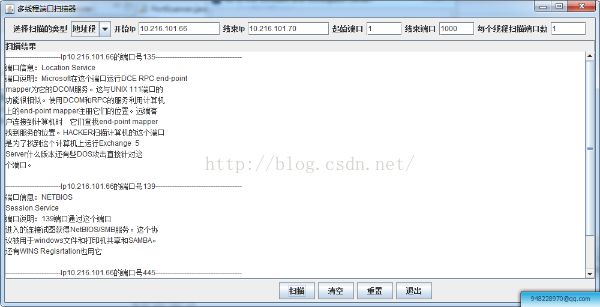多线程端口扫描器的实现(java)
这是我大三下学期课程设计的题目,没有想象中的那么难。
一、要求:
1.利用Socket通信机制实现一个多线程的端口扫描器。
2.设计要求:
2.1用户界面:用户可以输入IP地址或IP地址段;输入端口号或端口号范围;列表显示主机名、开放的端口及开放端口上相应的服务或恶意程序的名称;功能按钮。
2.2使用多线程机制对某一地址(段)的主机端口进行扫描;说明开放端口的类型(如UDP端口还是TCP端口);查询数据库,对开放的端口进行说明(如提供的服务或存在的风险)。
2.3有关端口与服务或恶意程序的映射关系保存为数据库表,以扫描出的开放端口号为关键字查询表,将端口的说明显示在界面的列表框中。
二、代码
功能实现类:
public class PortScanner{
public static void main(String[] args){
new EditorWin();
}
}
class EditorWin extends JFrame implements ActionListener {
private JLabel startIp,endIp,l_startPort,l_endPort,l_portOfThread ,showResult ,empty,type ,status;
private JTextField f_startIp,f_endIp,f_startPort,f_endPort,f_portOfThread ;
private JScrollPane result ;
private JComboBox comboBox ;
private JButton startScanner,exitScanner ,clear,reset;
private JPanel top,bottom ;
private JTextArea message ;
private String startIpStr ,endIpStr;
private int startPort,endPort,portOfThread ,threadNum ;
public EditorWin(){
this.setTitle("多线程端口扫描器") ;
startIp = new JLabel("扫描的Ip") ;
l_startPort = new JLabel("起始端口") ;
l_endPort = new JLabel("结束端口") ;
l_portOfThread = new JLabel("每个线程扫描端口数") ;
status=new JLabel("未开始扫描") ;
showResult = new JLabel("扫描结果") ;
endIp = new JLabel("结束Ip");
empty = new JLabel(" ") ;
type = new JLabel("选择扫描的类型") ;
startScanner = new JButton("扫描");
exitScanner = new JButton("退出");
clear = new JButton("清空") ;
reset = new JButton("重置") ;
f_endIp = new JTextField(12) ;
f_startIp = new JTextField(12) ;
f_startPort = new JTextField(5) ;
f_endPort = new JTextField(5) ;
f_portOfThread = new JTextField(5) ;
message = new JTextArea(20,20) ;
result = new JScrollPane(message) ;
result.setColumnHeaderView(showResult) ;
comboBox = new JComboBox() ;
comboBox.addItem("地址");
comboBox.addItem("地址段");
endIp.setVisible(false) ;
f_endIp.setVisible(false) ;
top = new JPanel() ;
top.add(type);
top.add(comboBox) ;
top.add(startIp) ;
top.add(f_startIp) ;
top.add(endIp) ;
top.add(f_endIp) ;
top.add(l_startPort) ;
top.add(f_startPort) ;
top.add(l_endPort) ;
top.add(f_endPort) ;
top.add(l_portOfThread) ;
top.add(f_portOfThread) ;
bottom = new JPanel() ;
bottom.add(status) ;
bottom.add(empty) ;
bottom.add(empty) ;
bottom.add(empty) ;
bottom.add(empty) ;
bottom.add(empty) ;
bottom.add(empty) ;
bottom.add(startScanner) ;
bottom.add(clear);
bottom.add(reset);
bottom.add(exitScanner) ;
this.add(top,BorderLayout.NORTH);
this.add(result,BorderLayout.CENTER) ;
this.add(bottom,BorderLayout.SOUTH) ;
comboBox.addActionListener(this) ;
startScanner.addActionListener(this) ;
exitScanner.addActionListener(this) ;
clear.addActionListener(this) ;
reset.addActionListener(this) ;
setSize(1000, 500);
setVisible(true);
setDefaultCloseOperation(JFrame.EXIT_ON_CLOSE);
}
@Override
public void actionPerformed(ActionEvent e) {
if(e.getSource()==startScanner){ //点击扫描按钮
//点击时刻
startIpStr = f_startIp.getText().trim() ; //得到输入的Ip
if(checkIP(startIpStr)){
//判断是否为数字
try{
startPort = Integer.parseInt(f_startPort.getText().trim()) ;
endPort = Integer.parseInt(f_endPort.getText().trim()) ;
portOfThread =Integer.parseInt(f_portOfThread.getText().trim()) ;
threadNum = (endPort-startPort)/portOfThread+1 ;
//普安段端口号的范围
if(startPort<0||endPort>65535||startPort>endPort){
JOptionPane.showMessageDialog(this, "端口号范围:0~65535,并且最大端口号应大于最小端口号!") ;
}
else{
if(portOfThread>endPort-startPort||portOfThread<1){
JOptionPane.showMessageDialog(this, "每个线程扫描的端口数不能大于所有的端口数且不能小于1") ;
}else{
if(((String) comboBox.getSelectedItem()).equals("地址")){
message.append("************************************************************"+"\n") ;
message.append("正在扫描 "+startIpStr+" 每个线程扫描端口个数"+portOfThread+"\n"+"开启的线程数"+threadNum+"\n") ;
message.append("开始端口 "+startPort+" 结束端口" +endPort+"\n") ;
message.append("主机名:"+getHostname(startIpStr)+"\n");
message.append("开放的端口如下:"+"\n") ;
for(int i = startPort;i <= endPort; i++) {
if((i + portOfThread) <= endPort) {
new Scan(i, i + portOfThread,startIpStr).start();
i += portOfThread;
}
else {
new Scan(i, endPort,startIpStr).start();
i += portOfThread;
}
}
}else{
endIpStr = f_endIp.getText() ;
if(checkIP(endIpStr)){
//扫描Ip地址段
Set ipSet = new HashSetpackage portScanner;
import java.sql.Connection;
import java.sql.DriverManager;
import java.sql.PreparedStatement;
import java.sql.ResultSet;
import java.sql.SQLException;
public final class JdbcUtils {
private static String url = "jdbc:mysql://localhost:3306/portInfo?useUnicode=true&characterEncoding=utf8";
private static String user = "root";
private static String psw = "root";
private static Connection conn;
static {
try {
Class.forName("com.mysql.jdbc.Driver");
} catch (ClassNotFoundException e) {
e.printStackTrace();
throw new RuntimeException(e);
}
}
/**
* 获取数据库的连接
* @return conn
*/
public static Connection getConnection() {
if(null == conn) {
try {
conn = DriverManager.getConnection(url, user, psw);
} catch (SQLException e) {
e.printStackTrace();
throw new RuntimeException(e);
}
}
return conn;
}
/**
* 释放资源
* @param conn
* @param pstmt
* @param rs
*/
public static void closeResources(Connection conn,PreparedStatement pstmt,ResultSet rs) {
if(null != rs) {
try {
rs.close();
} catch (SQLException e) {
e.printStackTrace();
throw new RuntimeException(e);
} finally {
if(null != pstmt) {
try {
pstmt.close();
} catch (SQLException e) {
e.printStackTrace();
throw new RuntimeException(e);
} finally {
if(null != conn) {
try {
conn.close();
} catch (SQLException e) {
e.printStackTrace();
throw new RuntimeException(e);
}
}
}
}
}
}
}
}
地址:
地址
(界面过于丑T-T)
四、多线程扫描端口算法的说明:
for(int i = startPort;i <= endPort; i++) {
//扫描开放的Ip
InetAddress.getByName(Ip);
if((i + portOfThread) <= endPort) {
new Scan(i, i + portOfThread,Ip).start();
i += portOfThread;
}
else {
new Scan(i, endPort,Ip).start();
i += portOfThread;
}

